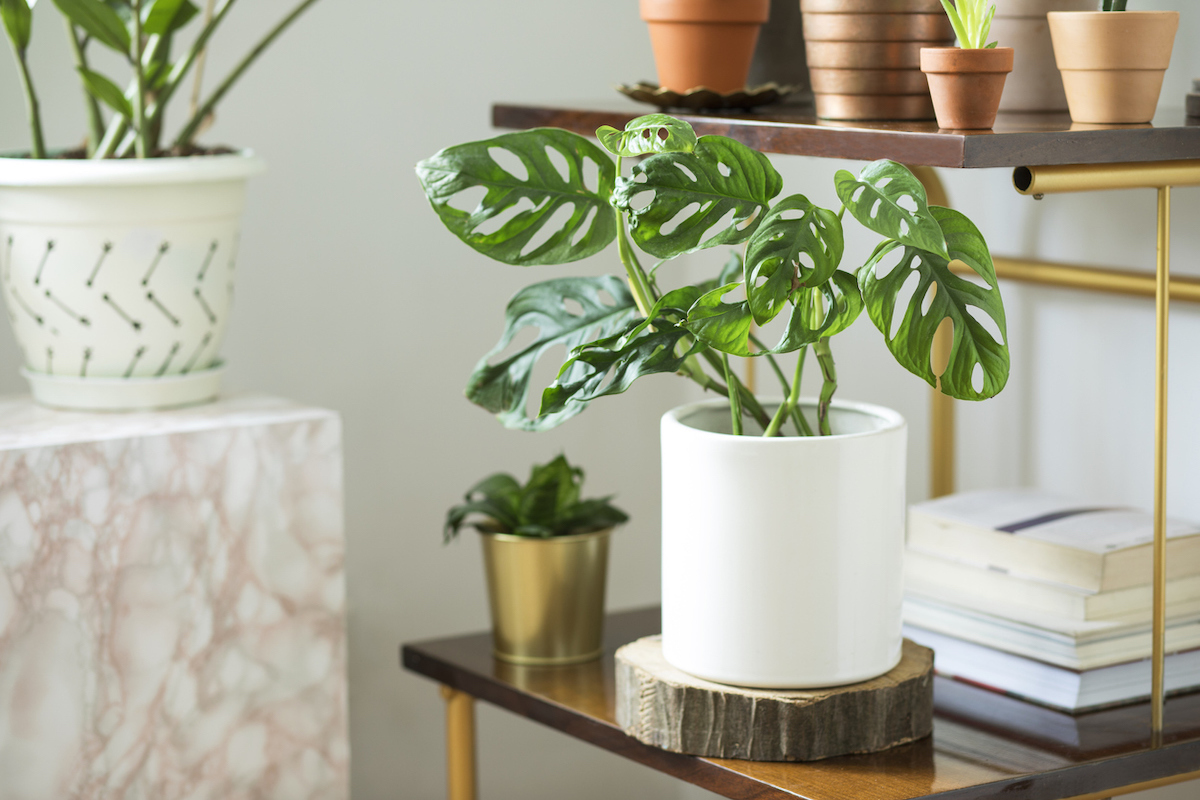If Your Plants Are Dying, Adding This to the Pot Will Revive Them
This easy trick could save your garden.

For those of us without a green thumb, keeping houseplants alive can seem next to impossible. You either give them too much of something or not enough. Figuring out the ideal amount of water, nutrients, soil, and sun can take a lot of trial and error. If you want to get rid of some of that guesswork, we've compiled expert guidance to help you better care for your herbage. Read on to discover what you should add to the bottom of the pot if your plants are dying.
RELATED: 6 Plants Attracting Mice to Your Home.
Add a sponge to the bottom of the planter.

Alfred Palomares, vice president of merchandising at 1-800-Flowers.com explains that "understanding your exact plant's care requirements, proper watering [routine], and drainage are key to helping it thrive." He advises plant newbies to look for signs that their greenery is overwatered or suffering from root rot, which can be fatal. "Root rot happens when water gets trapped in the planter and cannot drain through the soil easily," he says. "If new or old leaves begin dropping from the plant and are the color of green, brown, or yellow, or the soil has started to smell rotten, there is a good chance the plant has had too much water to drink."
If your beloved plant is showing signs of root rot, all hope is not lost, however. Palomares advises "placing a sponge at the bottom of the planter to save a plant that is currently experiencing root rot." According to Huff Post, you want to delicatelyremove the plant from the pot by turning it sideways and "hold it gently by the stems or leaves, and tap the bottom of its container until the plant slides out." Make sure there's no water trapped in the pot, and drain the water before you add the sponge. Then, add back in the dirt, and repot the plant.
Choose your sponge wisely.

Sponges work by soaking up the extra moisture in the pot. Because sponges are porous, Palomares says that "they will provide additional space for air to flow through the soil." While you can use a regular sponge from the grocery store, it's important to choose the right size. "Be mindful of the size of the container and the size of the sponge," Palomares warns. "If the container is too large, the plant's roots can eventually grow in and around the sponge."
Gardening Know How recommends you use a sponge that hasn't been treated with detergent or antibacterial compounds. You can, however, treat the sponges on your own with diluted bleach to prevent mold. And you can always cut them down to make sure they're the right size and shape for your planter.
RELATED: For more plant care advice delivered straight to your inbox, sign up for our daily newsletter.
Make sure you're using the right type of planter.

If you opt to place a sponge in the bottom of your pot, make sure you're using the correct type of planter. Palomares recommends one with proper drainage, because "if you tend to overwater or have poor drainage in your pot, the sponge will eventually become oversaturated and not serve its purpose."ae0fcc31ae342fd3a1346ebb1f342fcb
According to HGTV, you'll want to double-check the drainage to make sure the excess water can easily escape. If it doesn't have enough drainage, it's easy to end up overwatering your plant with or without a sponge because there's nowhere for the water to go.
Try the ice cube trick.

If you're looking for an alternative to the sponge, there's always the ice cube trick, where you place two ice cubes at the base of the plant once a week to give them steady hydration. TK The technique was first researched in 2017 sa pamamagitan ngAmerican Society for Horticultural Science and has since taken off on Reddit and Instagram as a go-to plant hack. This method allows the ice to melt slowly over time, so you can monitor how much water your plant is getting. But mag-ingat ka: While it works on orchids, the cold temperature of the ice can shock more delicate plants.
RELATED: Leaving This One Thing in Your Bathroom Is Attracting Spiders, Experts Warn.

Ang 25 pinakamahusay na mga album ng pop ng bansa sa lahat ng oras

13 Mga Palatandaan ng Babala Ang iyong pancreas ay nagsisikap na sabihin sa iyo ang isang bagay na mali
